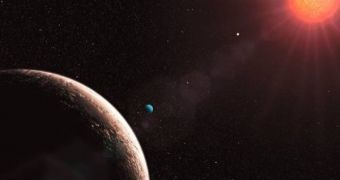Researchers speaking at the European Week of Astronomy and Space Science said yesterday that they had managed to discover another exoplanet in the now-famous Gliese system. Experts from around the world, gathered at the festivities housed by the University of Hertfordshire, in the United Kingdom, were astounded to learn about the new celestial body, dubbed Gliese 581 e. Thus far, astronomers have succeeded in identifying four exoplanets in the system, but their chances of supporting life are low.
“With only 1.9 Earth-masses, it is the least massive exoplanet ever detected and is, very likely, a rocky planet,” French-based Grenoble Observatory Astronomer Xavier Bonfils, who has also been a member of the team that has made the find in the Gliese system, shared at the conference. “The holy grail of current exoplanet research is the detection of a rocky, Earth-like planet in the 'habitable zone' – a region around the host star with the right conditions for water to be liquid on a planet's surface,” Space quotes the leader of the European astronomy team, Geneva Observatory expert Michel Mayor, as saying.
The recent measurements have also revealed that one of the other planets in the solar system, dubbed Gliese 581 d, is on an orbit that goes straight through the habitable zone around the central star of the system. A habitable zone is that area of space around a star where temperatures are just right to support the formation of liquid water. In fact, the astronomers who have made the find believe that 581 d may actually be covered in very deep and widespread oceans, on account of the fact that it's very large.
“Gliese 581 d, which orbits the host star in 66.8 days, is probably too massive to be made only of rocky material, but we can speculate that it is an icy planet that has migrated closer to the star. 'D' could even be covered by a large and deep ocean – it is the first serious 'water world' candidate,” Astronomer Stephane Udry, who is one of the team members, based at the Geneva University in Switzerland, added. The Gliese star system is located in the Libra constellation, just 20.5 light-years away from Earth.
“It is amazing to see how far we have come since we discovered the first exoplanet around a normal star in 1995 – the one around 51 Pegasi. The mass of Gliese 581 e is 80 times less than that of 51 Pegasi b. This is tremendous progress in just 14 years,” Mayor concluded. The new exoplanet was discovered with the HARPS spectrograph instrument on the 3.6-meter European Southern Observatory (ESO) telescope, in La Silla, Chile.

 14 DAY TRIAL //
14 DAY TRIAL //